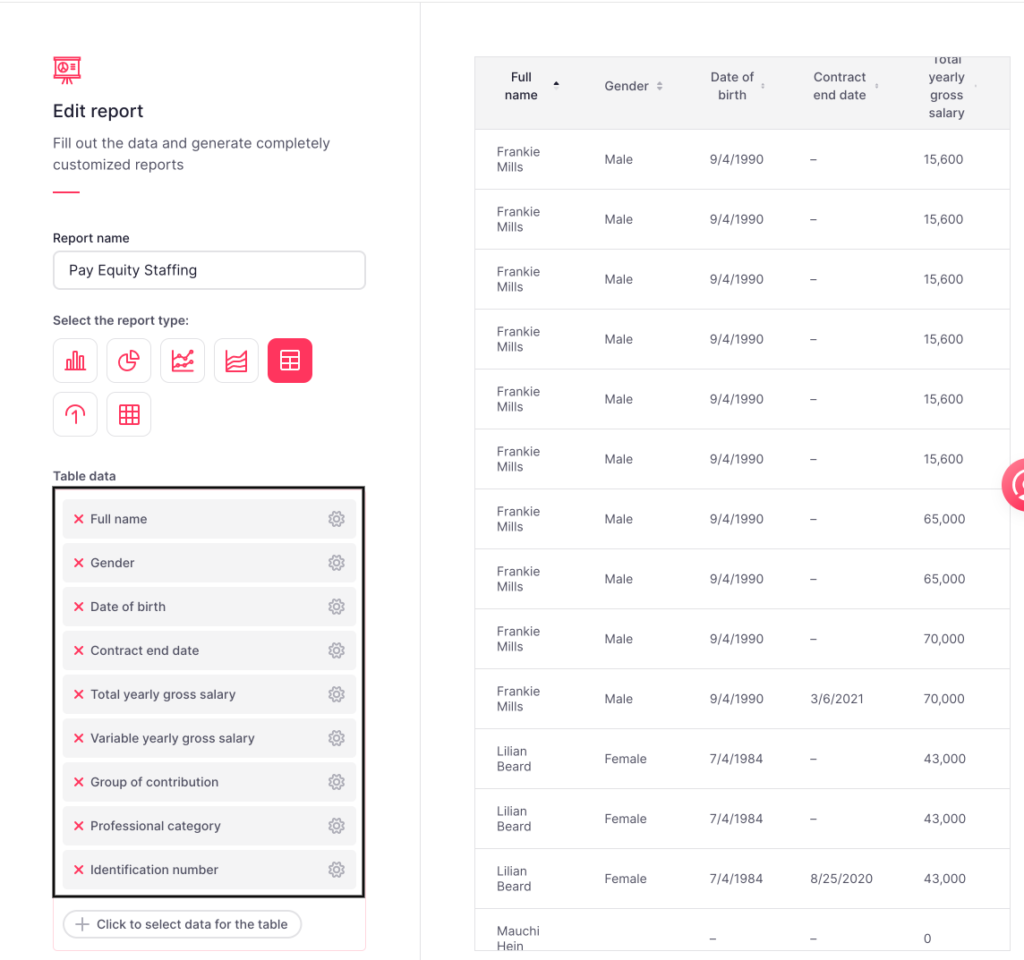Pay equity is a hot topic right now. This may be because of increased awareness around diversity, equity, and inclusion topics following the upheaval of the pandemic. Employees increasingly want to work with organizations doing their part to further social equity.
It is also because a number of companies have recently caught the attention of the media, government agencies and the Equal Employment Opportunity Commission as a result of unsubstantiated pay gaps. As a result, many companies are now proactively conducting audits and using pay equity analysis tools to ensure they are paying all staff a fair and equitable wage.
We have put together a step-by-step guide to help you understand this complex topic. Your burning questions like “What is a pay equity analysis?”, and “How do I conduct an internal pay equity analysis?” will be answered, finally. In addition, we will also discuss the benefits of using valuable tools that can make your life easier, such as a pay equity analysis template.
Pay Equity Definition
According to USA payroll laws, employers need to be sure that the salaries they are paying employees are fair and equitable across the board.
This is what’s known as pay equity: equal pay for all employees performing the same duties, regardless of gender, race, or any other defining characteristics. Pay equity laws in the U.S. such as the Equal Pay Act of 1963 aim to eliminate the gender pay gap and encourage transparent pay practices.
Even as traditional forms of discrimination fade, pay disparities persist for structural reasons. A study from the Economic Policy Institute, a liberal think tank, showed that in 2019, Black workers made 80% of the salary of white workers with similar levels of education. Even Black workers close gaps in educational attainment, the skills called for in an increasingly technologized workforce favor white workers.
Unfortunately, it remains clear that women remain overrepresented in low-paid fields, despite gains in educational attainment and work experience. Additional compensation data show disparities in pay become more significant where race and gender intersect.
A pay equity analysis, also known as an equal pay audit, is all about ensuring equal pay for equal work. Put simply, HR departments (or small business HR outsourcing companies) use a pay equity analysis tool in order to analyze pay rates within an organization and establish if there are any unjustified differences in pay. This is done through statistical analysis of payroll data.
The Importance of Conducting a Pay Equity Analysis
A pay equity analysis serves a number of functions. Firstly, it ensures you are paying all your employees fairly, helping you avoid any potential discrimination lawsuits. This is important because legal bodies like the EEOC are becoming increasingly focused on addressing the wage gap.
Secondly, a pay equity analysis is a great way for you to offer fair rates of pay, helping you attract and retain top talent by offering competitive rates and equal opportunities for all. It highlights your commitment to diversity, equity, inclusion and belonging (DEIB), and helps you stay relevant in a competitive market. Additionally, if your employees feel you are fair and offer equal opportunities for all, they are far more likely to be motivated and loyal members of staff.
Thirdly, and perhaps most obviously, promoting pay equity is important because your employees deserve to be compensated fairly if they’re doing work of equal value. Although you almost certainly intend to pay your employees equally, sometimes factors like unconscious bias or institutional discrimination lead to a pay gap. By conducting a pay equity analysis, you can reduce the likelihood of there being a gender pay gap or other pay inequities at your company.
Internal and External Pay Equity Analysis
Before we look at how to conduct a pay equity analysis, it’s important to highlight the distinction between external and internal pay equity.
External equity: involves comparing your business against the external market in order to determine if you are paying your employees in line with industry standards. This helps you ensure you are making competitive job offers and offering fair salary structures. Take into consideration some states have pay transparency laws making it easier to benchmark your company practices vs. competitors.
Internal equity: involves analyzing your own company to ensure you are paying your employees fairly. In other words, you aren’t paying unjustifiably low or high salaries to certain employees as a result of their age, race or gender, among other aspects. This includes reviewing your compensation policies and the salary history of your employees working the same job.
Ideally, you should look to conduct a regular internal and external pay equity analysis to help you create an equitable compensation strategy.
How to Conduct a Pay Equity Analysis
Now that we’ve looked at what a pay equity analysis is and why it’s so important, let’s break down the steps involved. This will help you implement your own regular audit schedule so that you can maintain internal pay equity and an equitable workplace.
Establish Goals
The first stage is establishing your goals. Why are you conducting a pay equity analysis? Is it to ensure compliance, update your pay practices, promote DEI, or respond to shareholder demand? It’s important to understand your primary goal so that you can define the best process and methodology to use when you conduct your pay audit.
Gather Data
Once you’re clear about why you are conducting a pay equity analysis, you need to start gathering data. The data you need to collect will depend on the scope and purpose of your audit. However, it will usually include the following information:
- Job titles and descriptions
- Departments, levels, roles and responsibilities
- Protected class identifiers such as age, gender, race, etc.
- Educational level and experience
- Seniority levels
- Hours worked
- Starting salaries
- Current salaries
- Promotions
- Bonuses and benefits
- Frequency and rate of pay increases
- Business practices
- Market data
The more information you gather, the better conclusions you will get from your analysis. With this information, you can create a detailed report about your compensation practices. Additionally, modify your pay structures and adjust any unfair wages. Make sure you design a pay equity analysis template to ensure you collect all the data you need (more on this below).
Analyze Data
The next step once you’ve collected all your data is to analyze it. There are two parts to this stage.
Firstly, you need to compare your organizational roles. This involves comparing similar roles within your company to see if all employees are being paid the same. Look at other job-related factors as well, such as responsibilities, how much experience is needed for this position, their impact with the company, and so on. However, you should also compare against different departments. For example, how much is a sales rep paid compared to a customer service agent?
Once you’ve done that, you need to determine if any identified differences in wages can be directly attributed to gender, race, age, or any other unjustified criteria. The best way to determine this is by using a regression analysis model, as we will see shortly.
Take Action
The final stage of your pay equity analysis is about taking action. You need to take your results and create a pay equity analysis report to present your conclusions. You then need to communicate your results with your leadership team and stakeholders. Now that you have your company’s compensation data, you’ll have compelling numbers to back up your claims to fight for equitable pay.
If you’ve identified pay gaps that you cannot legally or reasonably justify, you need to correct them as soon as possible. Keep in mind that you cannot legally reduce an employee’s salary without good reason, so adjustments will usually need to be made by means of salary increases for those who are being paid less. If you encounter any complications during this phase, seek out legal counsel to assist you.
How to Conduct a Gender Pay Equity Analysis
As we’ve already discussed, pay equity is about ensuring fairness for all, regardless of individual characteristics. One of these aspects is gender. And that’s where a gender pay equity analysis comes in. It’s important to undertake this type of analysis on a regular basis. This will ensure you aren’t unwittingly promoting a gender pay gap in your company.
When you conduct a gender pay equity analysis, it’s important not to just split your company into genders and compare pay without taking into consideration other aspects that might influence the salary an employee receives. You must also consider race, as women of color tend to receive the lowest salaries. A gender pay gap analysis will help you find any discrepancies in your pay practices.
You can also consider qualifications, work experience, geographic location, role or function, level, seniority, and performance ratings It’s important to take everything into account because all these aspects can legitimately lead to differences in pay. The best way to do this is by conducting a regression analysis.
How is Regression Analysis Used in Pay Equity Analysis?
One of the tools that you can use to analyze your gathered data is what’s known as regression analysis. This is a statistical technique that you can use to model your organization’s compensation system using any data that you believe may influence pay. As we saw above, this might include qualifications, work experience, geographic location, role or function, level, seniority, and performance ratings. A regression analysis takes into account all these factors so that you can determine to what extent gender or other protected characteristics may influence the compensation you offer your employees.
With regression analysis, you can establish if a range of variables is having a negative influence on your compensation strategy. It helps you determine if variables that are influencing the pay you offer are fair (e.g., you are paying one employee in a team more than another because they are more qualified), or unfair (e.g., the only reason you are paying said employee more is because they are a man/woman). A regression analysis allows you to analyze all control variables (e.g., job level), and compare them to independent variables (e.g., gender), and dependent variables (e.g., pay ratio). This helps ensure you are looking at the full and complete picture when you perform your pay equity analysis.
Creating a Pay Equity Analysis Excel Template
As we saw above, before you can conduct your audit, you need to have the right information to analyze. This includes employee data, job descriptions, business practices, market data, and salaries. You also need to consider the size of your business when you evaluate your salaries. Utilizing a pay equity analysis excel template can help you collect all the necessary information.
For example, you might collect:
- Gender distribution by grade and/or departments
- Male and female staff by age and length of service
- Race distribution by salary
- Part-time staff by gender, race and age
- A breakdown of total salary increases by department, job title, age, race and gender.
A pay equity analysis spreadsheet ensures you conduct a thorough audit. You just need to design a template with columns to collect all the necessary information. You can then use your pay equity analysis template to present your results to senior management and your shareholders. This will help you make your case effectively so that you can propose any necessary adjustments and ensure pay equity for all.
Easily conduct your pay equity analysis with our all-in-one HR software.






